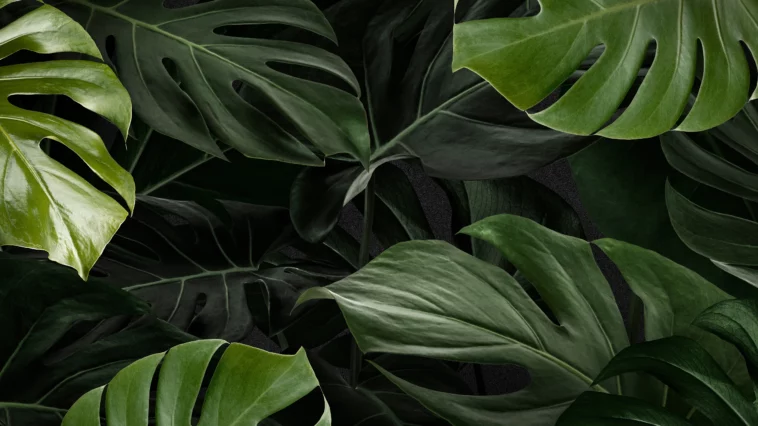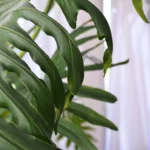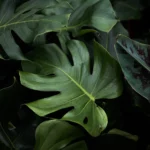It’s distressing to discover your beloved monstera plant’s leaves curling. Right now, you’re probably asking ‘Why are my Monstera leaves curling?’
This is an issue I’ve dealt with in the past, and I’ll explain how to resolve it in this post.
The most commonly encountered reasons of Monstera leaves curling are underwatering and temperature stress. It can also be caused by an overuse of fertilizer, poor water quality, diseases, or pest infestations.
Furthermore, poor light and excessive damp conditions may cause monstera leaves to curl.
Continue reading to learn how to quickly resolve the problems!
Read More: Monstera Leaves Care – A Complete Guide
Table of Contents
7 Causes of Monstera Leaves Curling
To determine why your Monstera leaves are curled, inspect the soil to see whether it looks too moist or too dry.
You should check to see if your monstera is receiving enough indirect light and room to flourish. You should also look for any symptoms of disease or pests.
Monstera leaves curl as a result of any factor that causes water loss or prevents plants from absorbing the required quantity.
To make it simple to implement, I’ll go through each possible cause and the measures to correct the issue and restore your monstera to its natural shape.
Read More: Why is my monstera drooping and curling
Monstera Leaves Curling Due to Underwatering
For the most part, this is the primary cause of Monstera leaf curling. Leaves will curl up if your monstera isn’t receiving enough water to perform the usual physiological process.
So, how can you be certain that the shortage of water is to blame?
Now inspect the potting soil to see whether the top soil is dry. If it is, look for browning leaves, brown tips or crispy leaf edges.
If you see any of these symptoms, you’re probably underwatering your Monstera. Another simple approach is to feel the weight of the container; if it’s dry, it’ll feel considerably lighter.
If your Monstera is underwaterd, it conserves water and survives by curving the leaves to reduce the space for transpiration (the process through which it loses water).
Read More: Do new monstera leaves curl
Underwatering Monstera: A Workaround
Keeping your Monstera well-watered all year long might be tricky, so here are some helpful tips:
- For an instant moisture repair, Soak the soil in water for a couple of minutes before allowing it to drain entirely.
- Instead of a frequency, you should be using a routine to see whether it wants a drink. When watering your Monstera, steadily add water until it starts to leak out of the drainage
- openings. Immediately empty the tray. Water the soil directly rather than soaking the leaves.
- Before watering, there are several things you may do to assess whether your plant is thirsty. Insert your fingers into the soil about 2-3 inches deep.
- In the event it comes out dry, your Monstera probably needs to drink! However, if it’s damp and there are clumps of soil, you might want to wait a few more days.
- As an alternative to guessing, you may purchase a moisture meter.
Read More: How do you get monstera leaves to uncurl
Monstera Leaves Curling Due to Overwatering
If the soil still seems wet a week after watering, you’ve definitely overwatered. This might cause the water to get stagnant, causing the roots to become suffocated.
There will be no oxygen available to the root system since water molecules have taken over the soil pores. Consequently, the Monstera’s ability to absorb nutrients and oxygen will be impaired. This will cause your plant’s leaves to curl.
Root rot and other fungal infections thrive in stagnant water. Infected monstera roots are unable to supply nutrients and water to other parts of the plant.
How to Fix Overwatering Problem
- Make sure you water your Monstera plant when it is thirsty. In order to verify the moisture level, you may use the finger technique described above.
- You can water your monstera using the alternate drying method by letting the soil dry in between waterings.
- Check that the drainage openings are correctly functioning to remove the excess water.
- If somehow the soil is hard and has low drainage ability, consider choosing a soil with excellent drainage capacity.
- To enhance drainage capacity, loosen the soil by adding perlite, sand, mulch, vermiculite, or compost.
Monstera leaf curling may be caused by chemicals found in tap water.
If you water your monstera with tap water, you may be causing an issue that may result in wrinkled and curled leaves.
I’m sure you’re asking, “How in the world?” Here’s how:
Chlorine and fluoride are often found in tap water. These chemicals are utilized to get rid of the microorganisms in the water.
If you use this water on a daily basis, the chemical will destroy the beneficial bacteria that live in the soil.
These microorganisms are beneficial to your monstera because they aid in the decomposition of organic waste, allowing nutrients to be absorbed by the roots.
When you frequently water your monstera with tap water, salts build up and destroy the root system.
It’s inevitable that the basic physiological functions of your monstera will be harmed. As a consequence, the leaves of your beloved monstera plant will curl.
Tap Water Solution
Following these procedures will allow you to repair any harm you’ve previously done:
- You’ll need to entirely replace the soil since it’s been contaminated by tap water. Use a soil that drains well.
- Repot the plant into fresh soil after trimming the damaged roots.
- When watering your monstera, always use filtered water.
- Tap water that contains chemicals such as chlorine should no longer be used. Let the water rest overnight at room temperature. It takes 24 hours for chlorine to evaporate from water.
- Another fantastic alternative for sustainable watering is rainwater or melting snow.
Store-bought filters need to be replaced often if they are being used. If you don’t, you’re likely contaminating your water rather than purifying it.
Monstera Leaves Curling Because of OverFertilization.
This is critical to learn while growing monstera in a container. I believe that the suggested fertilizer dosages on packaging are excessive.
That is why I propose applying a balanced fertilizer twice a month at half the required amount or less. You may be certain that your monstera will not suffer as a result.
When your plant is growing new leaves, it requires extra nutrients. This is the time of growth. Most plants, including monstera, do not need fertilization in the winter.
Overfertilization may kill your monstera. Overfertilizing damages or burns the roots. Then you may see signs such as leaf curling.
So, how can you know if you’re overfeeding your monstera too much out of kindness? Fortunately, you won’t have to go through any lengthy testing procedures at the lab. It’s simple to see with the human eye.
If you see any white crust accumulation around the container’s edges or on the soil’s surface, then you are guilty of overfeeding.
How to Correct an Over Fertilizing Problem.
- You must stop fertilizing if you’ve detected the problem of overfertilization.
- A new soil mix is required for repotting.
- Remember that under-fertilizing is preferable to over-fertilizing.
Temperature Stress Is Causing Monstera Leaves To Curl.
The curling of monstera leaves may occur when the temperature suddenly shifts. A comfortable room temperature ranges from 65°F to 85°F (18°C to 30°C), with a maximum of 60°F (15°C).
Because Monstera is a tropical plant, it is susceptible to the effects of cold temperatures.
As the temperature is low, Monstera growth is slowed; however, when the temperature rises, physiological processes are increased, and the plant attempts to cool itself by transpiring or losing extra water via its leaves.
This causes plant leaves to curl in order to conserve water by minimizing the amount of leaf surface exposed to light & temperature .
How to Solve the Temperature Stress Issue.
- Do your best to keep them away from drafty areas, such as around heaters, air conditioners, and fireplaces.
- A Monstera plant may be damaged if it is exposed to too much or too little light. The plant’s leaves are literally burned by direct sunlight, forcing them to curl inwards. In addition, the leaf tips may become brown.
- The monstera plant thrives best in an east-facing window. It is possible that heatwaves will affect the whole plant during the heat of the summer.
Diseases
When there is a damp or stagnant water in the container, the fungal disease arises. The major cause of this disease is excessive watering and poor drainage.
The disease is difficult to detect in its early stages. Check the roots if the soil is moist or wet and the leaves are curled.
If you notice brown and squishy roots with a terrible odor, it is almost certainly infested with root rot. Firm, white roots are a sign of good health.
How to Treat Root Rot
- Remove the plant from its container and thoroughly wash the root system.
- Use a sterilized scissors to remove the decaying or contaminated pieces.
- Allow one day for the plant to dry completely.
- Repot the plant in a new pot with fresh soil.
Insect Infestation
A few number of insects have been known to attack and harm monstera. It is nearly impossible to get rid of these insects entirely, but this article will offer some solutions to common monstera insects.
It is possible to find spider mite, thrips, and aphids draining the sap from your monstera. Insects that feed on the leaves’ nutrient-rich sap cause the leaves to curl up.
All of these insects are so little that you have to be extremely vigilant to see them and act on them. Make sure to look for them on both the top and bottom of the leaves, as well.
How to Get Rid of Insects
For my houseplants, I choose an organic or non-chemical approach to bug control and prevention.
Neem oil, dishwashing liquid detergent and rubbing alcohol are effective repellents for this kind of soft-bodied insects. If the infection is severe, chemical treatment may be necessary.
Low Humidity Causes Curling of Monstera Leaves.
It is possible for Monstera to flourish in a space with an average relative humidity. As a tropical plant, it is unable to tolerate low humidity. Suppose that the humidity is low?
When a plant releases its water, it’s known as transpiration. During low humidity, your monstera’s leaves lose more water than usual, causing them to curl up.
Using a hygrometer or the weather forecast on your smartphone, you may determine the humidity level. However, the humidity in the room will vary from the humidity outdoors.
The indicators of low humidity and underwatering are almost similar. Digital hygrometers are the best way to avoid any confusion.
Ideally, the humidity level in your house should be between 40 and 60 percent; if the humidity level in your home falls within this range, humidity is not a concern.
Fixing Monstera’s Low Humidity Problems.
- It is possible to raise the humidity level of your monstera if you follow these tips.
- Using a humidifier is the best method.
- Grouping all of your plants together is another method for boosting the overall humidity in your home. The emission of water vapor from plants causes a rise in humidity.
- Another do-it-yourself approach to increasing humidity for your monstera is the pebble tray.
- I’m not a supporter of misting to raise humidity, despite the fact that some people swear by it. If you mist your monstera leaves, you may be attracting fungal growth.
New Leaves
Bear in mind that fresh monstera leaves may curl, which is entirely natural. When it reaches a certain size, it will unroll by itself.
Conclusion
Why are my Monstera leaves curling?
The most typical causes of Monstera plant curling leaves are a lack of water and low humidity. Before delving into the specifics, remember these two most common challenges in mind.



